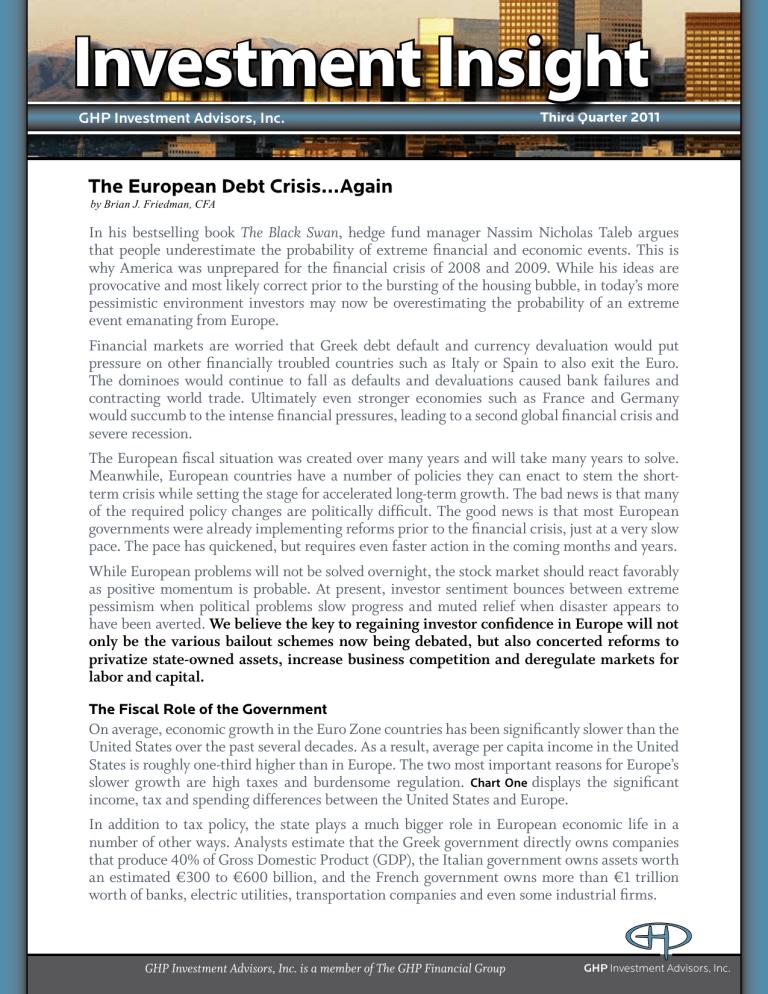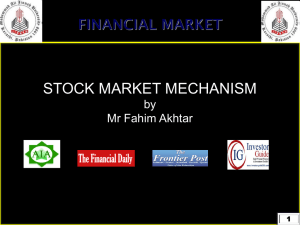Investment Insight The European Debt Crisis…Again

Investment Insight
GHP Investment Advisors, Inc.
Third Quarter 2011
The European Debt Crisis…Again
by Brian J. Friedman, CFA
In his bestselling book The Black Swan, hedge fund manager Nassim Nicholas Taleb argues that people underestimate the probability of extreme financial and economic events. This is why America was unprepared for the financial crisis of 2008 and 2009. While his ideas are provocative and most likely correct prior to the bursting of the housing bubble, in today’s more pessimistic environment investors may now be overestimating the probability of an extreme event emanating from Europe.
Financial markets are worried that Greek debt default and currency devaluation would put pressure on other financially troubled countries such as Italy or Spain to also exit the Euro.
The dominoes would continue to fall as defaults and devaluations caused bank failures and contracting world trade. Ultimately even stronger economies such as France and Germany would succumb to the intense financial pressures, leading to a second global financial crisis and severe recession.
The European fiscal situation was created over many years and will take many years to solve.
Meanwhile, European countries have a number of policies they can enact to stem the shortterm crisis while setting the stage for accelerated long-term growth. The bad news is that many of the required policy changes are politically difficult. The good news is that most European governments were already implementing reforms prior to the financial crisis, just at a very slow pace. The pace has quickened, but requires even faster action in the coming months and years.
While European problems will not be solved overnight, the stock market should react favorably as positive momentum is probable. At present, investor sentiment bounces between extreme pessimism when political problems slow progress and muted relief when disaster appears to have been averted. We believe the key to regaining investor confidence in Europe will not only be the various bailout schemes now being debated, but also concerted reforms to privatize state-owned assets, increase business competition and deregulate markets for labor and capital.
The Fiscal Role of the Government
On average, economic growth in the Euro Zone countries has been significantly slower than the
United States over the past several decades. As a result, average per capita income in the United
States is roughly one-third higher than in Europe. The two most important reasons for Europe’s slower growth are high taxes and burdensome regulation. Chart One displays the significant income, tax and spending differences between the United States and Europe.
In addition to tax policy, the state plays a much bigger role in European economic life in a number of other ways. Analysts estimate that the Greek government directly owns companies that produce 40% of Gross Domestic Product (GDP), the Italian government owns assets worth an estimated €300 to €600 billion, and the French government owns more than €1 trillion worth of banks, electric utilities, transportation companies and even some industrial firms.
GHP Investment Advisors, Inc. is a member of The GHP Financial Group GHP Investment Advisors, Inc.
Page 2
Selling state-owned assets would make a significant dent in government debt for all Euro Zone countries. Even the German government (both at the federal and state level) is a business owner, primarily owning certain financial institutions such as the Landesbanken (the German equivalent of a Savings & Loan). Privatization is hardly a new policy. All of the aforementioned governments have slowly privatized state-owned assets over the past 15 years. In most cases government businesses face very little competition so privatization accomplishes the dual goal of raising cash as well as injecting dynamism into moribund economic sectors.
The Regulatory Role of the Government
In addition to direct monopoly control of business assets, Euro Zone governments actively regulate their economies to create a more “orderly” (in their view) marketplace. Most governments in the Euro Zone impose regulations to limit business competition, constrain capital markets and protect jobs. By protecting existing jobs and employers, however, they reduce incentives to start new companies, innovate and hire additional employees. As a result of these policies many
European countries suffer from chronically high unemployment, low productivity growth and sluggish economies.
Chart Two compares productivity growth for countries that belong to the OECD (Organization for Economic Co-operation and Development). As you can see most major Euro Zone countries do not compare well. Productivity growth has been particularly sluggish in Italy and Spain, two of the countries now suffering the biggest financial problems. While Italy and Spain are more extreme examples, almost all Euro Zone countries increased their debt to plug the gap between their slowly growing incomes and their rapidly growing government spending. Note that Greece actually performed quite well, but its borrowing vastly exceeded its strong economic performance.
The bond markets have now cut the flow of credit to the worst offenders and slowed the flow to even stronger countries such as France. In response governments are reluctantly changing their policies. At present, they are relying on tax increases imposed on already highly taxed societies and predictably suffering slowing economic growth as a result. We believe a shift toward more market-oriented policies is inevitable given their limited ability to further raise taxes while the need to meet fiscal obligations remains. Only accelerated economic growth will solve this dilemma.
While more restrictive regulations are constraints on economic performance in a wide variety of areas, European labor laws are a very good example of opportunities available from deregulation.
Most European countries make it difficult and expensive for employers to fire their employees.
Moreover, many European countries are more heavily unionized or force all employers to participate in a national collective bargaining system sanctioned by law. Predictably, given the dynamic nature of economic change, employers only reluctantly hire given the costs of layoffs if circumstances change.
Despite our current problems in the United States, our economy has created jobs more successfully than Europe over the long term. Chart Three compares the percentage of the working age population employed in the United States vs. France, Italy and Spain. As you can see, the
U.S. has consistently employed a much larger percentage of the population even during this more severe recession.
Page 2
GHP Investment Advisors, Inc.
Page 2
France, Italy and Spain slowly deregulated their economies over the past 15 years with particular emphasis on labor markets. You can see the payoff in Chart Three as labor force participation steadily climbed. Unfortunately, this moderate pace of reform was overwhelmed by the financial crisis. More aggressive reforms are now required to improve competitiveness and growth.
Germany has already implemented many of the labor market reforms now being debated in
France, Italy and Spain. Chart Four shows the job market payoff over the past seven years. Despite significant improvement, however, German job creation only looks good relative to the current recession in the United States. Similar to the rest of Europe, Germany will require further economic liberalization to maintain economic and employment growth.
The Future of the Euro
Many pundits predict the demise of the Euro and an impending financial crisis as a result.
We do not share these views. True, European countries have significant problems, but they also have weapons in their arsenal to combat these problems. They have sufficient financial resources to prevent widespread bank failures, they have state-owned assets that can be privatized to raise cash for debt repayment, and they have the opportunity to implement reforms that will create jobs and accelerate growth.
Financial markets are concerned that politics will prevent European governments from using the weapons at their disposal. Euro Zone politicians have certainly demonstrated a talent for dithering. Rather than bold solutions, they take only the minimum actions necessary to temporarily calm the bond market. We doubt a bold solution is coming. So far, however, embedded within each short-term fix has been a small long-term reform. These small reforms will ultimately add up to a more substantial change.
Rather than a dramatic Black Swan financial crisis or a bold political response, the more likely scenario is continued small reforms, timid spending cuts and opportunistic tax hikes. The continued drama coming from European governments is masking the very strong financial condition of most European companies (with the exception of banks exposed to government debts). These companies would generally welcome the greater growth opportunities flowing from privatization and deregulation.
Outside of the monopolistic state sector, most private businesses in Europe are lobbying their governments for this outcome. Lost in the confusion is the simple fact that most people in
Europe work for the private sector and would benefit from reform.
Over time they will likely prevail despite vocal opposition from state sector employees, pensioners and government monopolies. The bond market is now the private sector’s ally. We believe the European sovereign debt crisis is setting the stage for a much more competitive Europe, not a world of competitive devaluation and economic collapse.
Page 3
GHP Investment Advisors, Inc.
Page 4
3.0%
2.0%
1.0%
0%
Chart 1
CHART 1
United States
Ireland
Spain
Greece
United Kingdom
Portugal
Germany
Netherlands
Italy
France
Belgium
GDP per
Capita
$47,200
$37,300
$29,400
$29,600
$34,800
$23,000
$35,700
$40,300
$30,500
$33,100
$37,800
43.3%
45.9%
46.6%
48.8%
48.9%
Taxes
% GDP
32.0%
34.6%
35.7%
38.8%
40.6%
41.5%
Govt. Expenditures
%GDP
42.3%
67.0%
45.0%
49.5%
51.0%
50.7%
46.7%
51.2%
50.6%
56.2%
53.1%
Source: www.cia.gov; www.oecd.org
Chart 2
CHART 2
OECD Long-term Productivity Growth
5.0%
Page 2
4.0%
Source: www.oecd.org
GHP Investment Advisors, Inc.
Chart 3
Percentage of the Population Employed
65.0
60.0
55.0
50.0
45.0
80.0
75.0
70.0
40.0
1995 1996 199
7
1998 1999 2000
United States
20
01
2002 2003 2004 2005 2006 20
07
France Italy Spain
2008 2009 201
0
Source: www.oecd.org
Page 2
Chart 4
Germany Capitalizing on Reforms
80.0
78.0
76.0
74.0
72.0
70.0
68.0
66.0
64.0
62.0
60.0
1995 1996 199
7
1998 1999 2000 20
01
United States
2002 2003 2004 2005 2006 20
07
United Kingdom Germany
2008 2009 201
0
Source: www.oecd.org
Page 5
GHP Investment Advisors, Inc.
Market Summary
Key Financial Ratios for Domestic Asset Classes
Asset Class
Large-Cap Growth Stocks
Price/Earnings
2011:Q3
14.0
P/E
Benchmark
27.0
Over/ Under
Valuation
Price/Book
Value
2011:Q3
2.9
Large-Cap Value Stocks
Mid-Cap Growth Stocks
Mid-Cap Value Stocks
Small-Cap Growth Stocks
10.9
17.6
14.9
17.0
20.2
24.8
19.1
23.2
-48.1%
-46.0%
-29.0%
-22.0%
-26.7%
1.3
2.6
1.3
2.1
Small-Cap Value Stocks 20.4
18.2
12.1% 1.2
P/BV
Benchmark
5.7
2.5
4.5
2.2
3.5
2.1
Over/ Under
Valuation
-49.1%
-48.0%
-42.2%
-40.9%
-40.0%
-42.9%
*Please note that the P/E data reported above are based on “as reported” earnings information rather than “operating” earnings. “As reported” earnings include one time write-offs whereas “operating” earnings reflect the profitability of a company as a going concern. We believe P/E’s based on operating earnings are a better long-term valuation indicator, but Standard and Poor’s does not report this information for the style indexes used in our calculations. Amid economic recession, declining earnings impact price-related ratios and “as reported” earnings can be significantly lower than “operating” earnings (particularly in the Value segment of the market) due to large write-offs. As a result, the P/E ratios listed above are higher than they would be using “operating” earnings for the denominator. To address this issue we have included Price to Book Value (P/BV) data, which are less affected by the impact of declining earnings and large write-offs.
GHP Investment Advisors, Inc. benchmarks are based on proprietary discounted cash flow models. P/E and P/BV data provided by Bloomberg L.P. as of 9/30/11.
Returns by Index
Index
DJIA Total Return
NASDAQ
S&P 500
S&P 500/Value
S&P 500/Growth
S&P MidCap 400/Value
S&P MidCap 400/Growth
S&P SmallCap 600/Value
S&P SmallCap 600/Growth
2011:Q3*
-11.50%
-12.69%
-13.87%
-16.30%
-11.56%
-20.95%
-18.83%
-20.04%
-19.63%
YTD*
-3.91%
-8.32%
-8.68%
-11.92%
-5.56%
-15.80%
-10.16%
-16.83%
-10.56%
DJIA & NASDAQ: Bloomberg L.P. as of 9/30/11.
S&P Returns: Standard & Poor’s Financial Services LLC. (2011). S & P Indices. In Standard & Poor’s/ Americas. Retrieved
October 3, 2011, from http://www.standardandpoors.com/home/en/us
*Dividends Reinvested.
Page 7 GHP Investment Advisors, Inc.
GHP
Investment Advisors, Inc.
Registered Investment Advisor
1670 Broadway, Suite 3000
Denver, Colorado 80202
P 303.831.5000
F 303.831.5082
Invest@GHPIA.com www.GHPIA.com
Brian J. Friedman, CFA
President
Robert W. Hochstadt, CPA/PFS
Senior Principal
Steven I. Levey, CPA/PFS
Senior Principal
David J. May
Investment Analyst
Carin D. Wagner, CFP ®
Wealth Management Advisor
Sommer C. Vincent
Client Relations Manager
Mike Sullivan, CFP ®
Financial Planning Associate
Katy Evans
Marketing Analyst
Deirdre McGuire
Client Relations Assistant
Ed Leone Jr., DMD, MBA, RFC
Associate
Investment Insight is published as a service to our clients and other interested parties. The information within is not intended as investment advice.
To update your address or to request additional copies of Investment Insight, please contact Sommer Vincent at (303) 831-5055.



